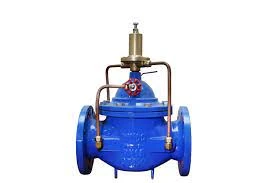Working principles of pressure relief valves and pressure holding pressure relief valves:
1. Act as pressure relief valves: when the pressure relief valve and the pressure holding pilot valve are adjusted to a pressure relief state, water flows to the outlet through the needle valve, the main valve control room, ball valve A, the pressure relief/pressure holding pilot valve and ball valve B, and the main valve is in an open state at this time. When the inlet pressure exceeds the safety value set by the pressure relief/pressure holding pilot valve, the pressure relief pilot valve will automatically open, and some water will be released through the ball valve C to relieve the pressure of the pipeline. When the pressure returns to a safe value, the pressure relief valve closes automatically. When acting as pressure relief valves, each ball valve is normally open.
2. Act as pressure-holding valves: when the pressure relief/pressure-holding pilot valve is adjusted to a pressure-holding state, the pilot valve will be closed as long as the inlet water pressure of the main valve is lower than the set value of the pilot valve. The pressure from the main control room is boosted and the main valve is closed.
3. When the upstream water supply pressure of the main valve exceeds the set pressure of the pilot valve, the pressure-holding pilot valve can be opened, the water in the control room is discharged to the outlet through the ball valve, and the pressure-reducing main valve in the control room is opened to start water supply, that is, the upstream water pressure is maintained. When used as a pressure-holding valve, ball valve C is normally closed or replaced with a plug.

1. Act as pressure relief valves: when the pressure relief valve and the pressure holding pilot valve are adjusted to a pressure relief state, water flows to the outlet through the needle valve, the main valve control room, ball valve A, the pressure relief/pressure holding pilot valve and ball valve B, and the main valve is in an open state at this time. When the inlet pressure exceeds the safety value set by the pressure relief/pressure holding pilot valve, the pressure relief pilot valve will automatically open, and some water will be released through the ball valve C to relieve the pressure of the pipeline. When the pressure returns to a safe value, the pressure relief valve closes automatically. When acting as pressure relief valves, each ball valve is normally open.
2. Act as pressure-holding valves: when the pressure relief/pressure-holding pilot valve is adjusted to a pressure-holding state, the pilot valve will be closed as long as the inlet water pressure of the main valve is lower than the set value of the pilot valve. The pressure from the main control room is boosted and the main valve is closed.
3. When the upstream water supply pressure of the main valve exceeds the set pressure of the pilot valve, the pressure-holding pilot valve can be opened, the water in the control room is discharged to the outlet through the ball valve, and the pressure-reducing main valve in the control room is opened to start water supply, that is, the upstream water pressure is maintained. When used as a pressure-holding valve, ball valve C is normally closed or replaced with a plug.

